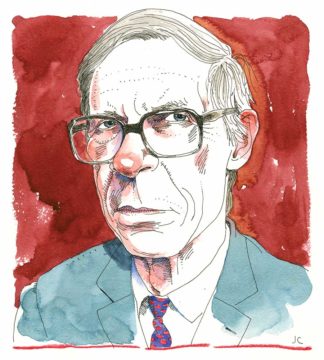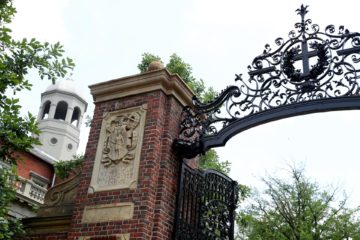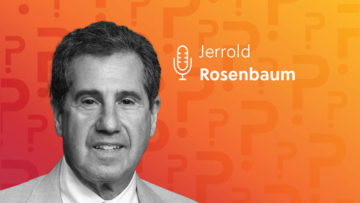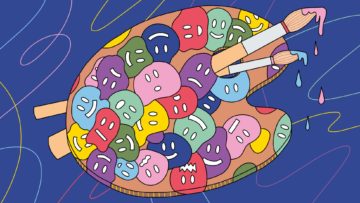by Brooks Riley

by Brooks Riley

by Rafaël Newman

Leave plenty of time to stand in line at the gift shop when you visit Einsiedeln Abbey, in the Swiss canton of Schwyz. The Klosterladen, in a courtyard to the right of the 18th-century complex—which is built on the site of the 9th-century hermitage where Saint Meinrad was sustained by the Waldleute, or Forest People—sells inspirational books by religious luminaries past and present, CDs of organ music and Gregorian chants, specialty baked goods, local wines and spirits, and Einsiedler Raben, gianduja-filled pairs of chocolate ravens, as delicious as they are ominous. There are ranks of postcards, inspirational and touristic, holy pictures, incense, and all manner of candles. But the gift shop’s main attraction for pilgrims at the Abbey, long a standard stop on the Way of St. James, are its devotional trinkets: rosaries, amulets, icons, and, in particular, medallions bearing the likeness of a saint or Biblical figure, all kept in black velvet-lined display drawers at the checkout, viewable only with the assistance of the lone cashier. Pilgrims from North America, Eastern Europe, Asia, and across the Catholic world linger reverently over the offerings, oblivious to those behind them, like so many fan girls and boys at Comic-Con; and they leave, bedecked in the gawdy signs of their faith, resembling participants in a cosplay event.

This jarring, strange-making, for believers no doubt sacrilegious impression, of an ancient, global monotheism as modern sci-fi genre, is compounded, as well as mitigated, by a glimpse of the proper object of the pilgrims’ veneration in the Benedictine Abbey’s cathedral church. Under a soaring ceiling adorned with the most gorgeously overwrought productions of counter-reformation Baroque—putti, florets, nativities, trompe-l’œil cameos, all in icing-sugar pinks, blues, and ochres—stands the glittering black marble Chapel of Our Lady, its plain stone bas-relief insets creating a two-tone reproach to the frivolity above. Within the chapel, however, inaccessible behind its wrought-iron grilles but open to view on three sides, the sternness is tempered, like the miraculous transition from black-and-white to Technicolor in The Wizard of Oz, by a further polychrome effusion: Einsiedeln’s celebrated, late Gothic Schwarze Madonna, a foot-and-a-half-tall wooden effigy of Mary, carved out of limewood, its 15th-century paint long since worn away and blackened by soot and smoke. The Black Madonna, holding the infant Jesus in her left hand and a scepter in her right, is suspended on the back wall of the chapel against a golden bas-relief combustion of cloud and rays of holy illumination. She is regularly clad and re-clad, in keeping with the ecclesiastical calendar, in an ever-changing sacred wardrobe of 27 dresses, gorgeously brocaded and complete with all the requisite accessories (as well as a matching outfit for Baby Jesus), each with its own liturgical or geographic appellation: the “Neues Florenzer”, the “Menzinger”, the “Altes Engelweih”, the “Innsbrucker”, one more enchanting than the other. Before the chapel, with the most direct view of the effigy, pews have been erected to allow worshippers to kneel and adore the Virgin. The effect on the outsider to this rite is of a children’s birthday party, whose guests are rapt in admiration of the showpiece gift, the very latest Barbie: Diversity Queen of the Universe™. Read more »
by Eric J. Weiner
We find our voice in solitude, and we bring it to public and private conversations that enrich our capacity for self-reflection. Now that circle has been disrupted; there is a crisis in our capacity to be alone and together. But we are in flight from those face-t0-face conversations that enrich our imaginations and shepherd the imagined into the real. There is a crisis in our ability to understand others and be heard. — Sherry Turkle, Reclaiming Conversation
 Although there might be nothing wrong with our hearing, we are quickly losing our ability to practice three formative modalities of democratic listening: Mindful, Aesthetic and Critical. These three modalities support our active participation in sustained, intimate conversations where we learn with and from each other. Millennials in particular struggle to listen to their friends, parents, and teachers for more than a few seconds without their brains becoming distracted by the ubiquitous hand of technology.[1] Adding to the distractions of technology, both adults and children, when in dialogue, confuse waiting for their turn to talk with the practice of democratic listening. Although we are hardwired for grammar;[2] cognitively mapped to construct, comprehend, and interpret meanings that arise from the soundscapes of language, culture and history; and can distinguish sound patterns, dissonances, silences, and noises in the ether,[3] the brain listens only to what the mind is prepared to hear.[4]
Although there might be nothing wrong with our hearing, we are quickly losing our ability to practice three formative modalities of democratic listening: Mindful, Aesthetic and Critical. These three modalities support our active participation in sustained, intimate conversations where we learn with and from each other. Millennials in particular struggle to listen to their friends, parents, and teachers for more than a few seconds without their brains becoming distracted by the ubiquitous hand of technology.[1] Adding to the distractions of technology, both adults and children, when in dialogue, confuse waiting for their turn to talk with the practice of democratic listening. Although we are hardwired for grammar;[2] cognitively mapped to construct, comprehend, and interpret meanings that arise from the soundscapes of language, culture and history; and can distinguish sound patterns, dissonances, silences, and noises in the ether,[3] the brain listens only to what the mind is prepared to hear.[4]
In our current historical conjuncture, the mind is not prepared nor is it being prepared to hear the pangs of hunger in the discourse of poverty; the terrorizing memories of male violence and sexual assault from the mother-tongue of surviving women; the anxieties of dis-ease and economic insecurity in the angry and disillusioned voices of youth; the brutality of homelessness in the quiet drawings of children who sleep in cars and shelters; the academic discourse of white supremacy deeply embedded within the sterilized language of meritocracy; the communality of working-class culture splattered in blood, sweat, and country; the groan of disability pushing against the structural forces of ableism; the tongue-tying of identity within sequestered spaces of difference; the diverse voices of radical love driving the outrage against fascist machineries of death; the intubated wheezing of dying democracies; the hushed courage of LGBTQ+ people navigating the heteronormative and cis-gendered architecture of everyday life; and the incessant white noise of power burying the refrain of negative freedom in the hook of capitalist opportunity. That which the mind is not prepared to hear negates our capacity to listen and understand, to learn from those most in need, and to be mindful, aesthetically sensitive, and critically awake to the radical possibilities that arise out of deep and meaningful conversation.
From this perspective, democratic listening, like its genetic siblings literacy and learning, should be understood as a social practice. Read more »
by Sarah Firisen
 Many years ago, I returned to my old high school for a visit with friends who were classmates back in the ’80s. Exploring the school and marveling over what had changed and what remained exactly the same, we ventured into the language lab. The room smelled exactly the same as it had in 1983, and it took me right back to those days of incredibly boring language lessons and sitting in that room with headphones on repeating monotonous phrases.
Many years ago, I returned to my old high school for a visit with friends who were classmates back in the ’80s. Exploring the school and marveling over what had changed and what remained exactly the same, we ventured into the language lab. The room smelled exactly the same as it had in 1983, and it took me right back to those days of incredibly boring language lessons and sitting in that room with headphones on repeating monotonous phrases.
I took French for seven years in middle and high school, Latin for five, and German for two. Language classes were always my educational Achilles heel. Those seven years enabled me to speak the most halting, grammatically painful, badly accented French when we visited on vacation, and I’ve always wished I spoke it better.
I’m now planning to visit Paris in January with my daughters, Sasha, 18, Anya, 21, and Anya’s boyfriend, Liam. Growing up in the U.S., they all learned Spanish in school rather than the de rigor in the UK, French. My daughters never showed much more linguistic aptitude than I did in school. In preparation for our trip, Anya suggested that we all download Duolingo, a language learning app. Read more »
by Bill Murray
 Cogito Ergo Sum? Welcome to the party. There’s a lot more going on out there than we sometimes think: Cephalopods memorize, learn, invent, and play; indeed, they acquire information about the outside world while still in their eggs. • The small, flowering thale, or mouse-ear cress, can detect the vibrations caused by caterpillars munching on it and so release oils and chemicals to repel the insects. • The fruit fly Drosophila shows evidence of depression if it gets too hot. • Plants discern the difference between blue and red light, and use this information to know which direction to grow. They differentiate between the dimming scarlet light of sunset and the brightening orange light of sunrise, to determine when to flower. • Pigs comprehend symbolic language, plan for the future and discern the intentions of others. They bore easily and show a clear preference for novelty. • When researchers arranged oat flakes in the geographical pattern of cities around Tokyo, slime mold constructed nutrient channeling tubes that closely mimicked Tokyo’s metro rail. • Some plants can feel you touching them. • Cuvier’s beaked whales can dive to 10,000 feet and stay there, at tremendous pressure, for up to two hours. In 2020 scientists recorded a Cuvier’s beaked whale staying below the water for 3 hours 42 minutes. • The nearly blind star-nosed mole, the world’s fastest eater, can find and gobble down an insect or worm in a quarter of a second. It hunts by bopping its star against the soil as quickly as possible, touching 10 or 12 different places in a single second. • The 10 centimeter long cleaner wrasse, a reef fish, has joined great apes, bottlenose dolphins, killer whales, Eurasian magpies and a particular Asian elephant in exhibiting self-awareness. Read more »
Cogito Ergo Sum? Welcome to the party. There’s a lot more going on out there than we sometimes think: Cephalopods memorize, learn, invent, and play; indeed, they acquire information about the outside world while still in their eggs. • The small, flowering thale, or mouse-ear cress, can detect the vibrations caused by caterpillars munching on it and so release oils and chemicals to repel the insects. • The fruit fly Drosophila shows evidence of depression if it gets too hot. • Plants discern the difference between blue and red light, and use this information to know which direction to grow. They differentiate between the dimming scarlet light of sunset and the brightening orange light of sunrise, to determine when to flower. • Pigs comprehend symbolic language, plan for the future and discern the intentions of others. They bore easily and show a clear preference for novelty. • When researchers arranged oat flakes in the geographical pattern of cities around Tokyo, slime mold constructed nutrient channeling tubes that closely mimicked Tokyo’s metro rail. • Some plants can feel you touching them. • Cuvier’s beaked whales can dive to 10,000 feet and stay there, at tremendous pressure, for up to two hours. In 2020 scientists recorded a Cuvier’s beaked whale staying below the water for 3 hours 42 minutes. • The nearly blind star-nosed mole, the world’s fastest eater, can find and gobble down an insect or worm in a quarter of a second. It hunts by bopping its star against the soil as quickly as possible, touching 10 or 12 different places in a single second. • The 10 centimeter long cleaner wrasse, a reef fish, has joined great apes, bottlenose dolphins, killer whales, Eurasian magpies and a particular Asian elephant in exhibiting self-awareness. Read more »
by Bill Benzon
ASC, “altered states of consciousness” – I don’t know when the term was first coined, but I became aware of it late in the 1960s. I took it as referring primarily to states of mind induced by psychoactive drugs, such as marijuana, mescaline, and LSD, and to states induced by meditative practice. It presupposes “ordinary consciousness,” which is hardly a single thing when you consider that one can ordinarily be daydreaming, working a math problem, eating a meal, perhaps a good meal, perhaps one that is merely tolerable, hiking in the woods, and so forth, for a long and various list of activities, all of them ordinary.
Music is one of those activities, one I treasure a great deal. I my experience states of musical consciousness can be quite various, some tending toward the ordinary other rather extraordinary. When I was eleven or twelve I read the this is Jean-Baptiste Arban’s Complete Conservatory Method for Trumpet, originally published in mid-nineteenth century France, and variously edited and reprinted since then. Arban is expressing his hopes for the instrument:
There are other things of so elevated and subtle a nature that neither speech nor writing can clearly explain them. They are felt, they are conceived, but they are not to be explained; and yet these things constitute the elevated style, the grande ecole, which it is my ambition to institute for the cornet, even as they already exist for singing and the various kinds of instruments.
What was he talking about? What does he mean by “grande ecole”? I doubt that I sought out an English translation. Whatever it was, it seemed important, albeit mysterious. Perhaps even, important because mysterious.
Does this grande ecole involve an altered state of consciousness?
Rock and Roll
During the early 1970s, while I was working on a master’s degree at Johns Hopkins in Baltimore, I played with a rock band called St. Matthew Passion. We modeled ourselves on Blood, Sweat, and Tears and on Chicago, bands that blended elements of jazz with rock. Thus, in addition to a four-piece rhythm section (guitar, bass, keyboards, drums) we had three horns: sax, trumpet (me), and trombone. Read more »
by Pranab Bardhan
All of the articles in this series can be found here.
 At MIT outside the Economics Department there was one scholar, whose several lectures I have attended was Noam Chomsky. I knew of him as a pioneer in modern linguistic theory, but his fame in the outside world is as America’s topmost dissenter (his position is somewhat like what used to be that of Bertrand Russell in Britain, a towering figure in his own subject philosophy, but his fame outside was that of Britain’s leading dissenter).
At MIT outside the Economics Department there was one scholar, whose several lectures I have attended was Noam Chomsky. I knew of him as a pioneer in modern linguistic theory, but his fame in the outside world is as America’s topmost dissenter (his position is somewhat like what used to be that of Bertrand Russell in Britain, a towering figure in his own subject philosophy, but his fame outside was that of Britain’s leading dissenter).
Chomsky in his lectures used to tirelessly blast the framework of American imperial policy, the capitalist military-industrial complex, the corporate-controlled media machinery for manufacturing consent, and the near-complete lack of control of common people over economic policy. I often agreed with the main thrust of his lectures, but the question that nagged me, but never could ask him in the surging crowd of his admirers around, was about the feasibility of the socio-political alternatives he might have in mind.
In some of his writings his constructive ideas seem close to old-style left-libertarian or anarcho-syndicalist views; in one place he describes his ideological position as revolving around “nourishing the libertarian and creative character of the human being”. What little I have read of this positive side of his ideological position has left me somewhat unconvinced; I have wondered if he has fully applied his mind to the various problems that arise in the real world beyond the anarchist or left-libertarian utopia. Read more »
Joanna Kavenna in Literary Review:
 Inverting the old cliché, Christopher Hitchens said, ‘Everyone has a book in them and that, in most cases, is where it should stay.’ The journalist and satirist Karl Kraus agreed: journalists, especially, should never write novels. This was self-satire, partly. Yet there are writers who can barely go to the shops without publishing a voluminous account immediately afterwards. At the other end of this unscientific spectrum are writers who destroy their work, either because they think it’s rubbish (Joyce, Stevenson, etc) or because they’ve become recently convinced it was written by the Devil (Gogol). Some people doubt themselves far too much, others not remotely enough.
Inverting the old cliché, Christopher Hitchens said, ‘Everyone has a book in them and that, in most cases, is where it should stay.’ The journalist and satirist Karl Kraus agreed: journalists, especially, should never write novels. This was self-satire, partly. Yet there are writers who can barely go to the shops without publishing a voluminous account immediately afterwards. At the other end of this unscientific spectrum are writers who destroy their work, either because they think it’s rubbish (Joyce, Stevenson, etc) or because they’ve become recently convinced it was written by the Devil (Gogol). Some people doubt themselves far too much, others not remotely enough.
With some or none of this in mind, the Polish author Wisława Szymborska, who died in 2012, destroyed 90 per cent of her writing. Despite that (or maybe because of it), she won the Nobel Prize in 1996 for ‘poetry that … allows the historical and biological context to come to light in fragments of human reality’. I have no idea what that means either.
More here.
Natalie Wolchover in Quanta:
 To look back in time at the cosmos’s infancy and witness the first stars flicker on, you must first grind a mirror as big as a house. Its surface must be so smooth that, if the mirror were the scale of a continent, it would feature no hill or valley greater than ankle height. Only a mirror so huge and smooth can collect and focus the faint light coming from the farthest galaxies in the sky — light that left its source long ago and therefore shows the galaxies as they appeared in the ancient past, when the universe was young. The very faintest, farthest galaxies we would see still in the process of being born, when mysterious forces conspired in the dark and the first crops of stars started to shine.
To look back in time at the cosmos’s infancy and witness the first stars flicker on, you must first grind a mirror as big as a house. Its surface must be so smooth that, if the mirror were the scale of a continent, it would feature no hill or valley greater than ankle height. Only a mirror so huge and smooth can collect and focus the faint light coming from the farthest galaxies in the sky — light that left its source long ago and therefore shows the galaxies as they appeared in the ancient past, when the universe was young. The very faintest, farthest galaxies we would see still in the process of being born, when mysterious forces conspired in the dark and the first crops of stars started to shine.
But to read that early chapter in the universe’s history — to learn the nature of those first, probably gargantuan stars, to learn about the invisible matter whose gravity coaxed them into being, and about the roles of magnetism and turbulence, and how enormous black holes grew and worked their way into galaxies’ centers — an exceptional mirror is not nearly enough.
More here.
Olúfémi O. Táíwò in The Nation:
 With its doctrine of fairness, A Theory of Justice transformed political philosophy. The English historian Peter Laslett had described the field as “dead” in 1956; with Rawls’s book that changed almost overnight. Now philosophers were arguing about the nature of Rawlsian principles and their implications—and for that matter were once again interested in matters of political and economic justice. Rawls’s terms became lingua franca: Many considered how his arguments, focused mostly on domestic or national issues of justice, might be applied to questions of international justice as well. Others sought to extend his theory’s set of political principles, while still others probed the limits of Rawls’s epistemology and the narrowness of his focus on individuals. A decade after A Theory of Justice appeared, Forrester notes, 2,512 books and articles had been published engaging with its central claims.
With its doctrine of fairness, A Theory of Justice transformed political philosophy. The English historian Peter Laslett had described the field as “dead” in 1956; with Rawls’s book that changed almost overnight. Now philosophers were arguing about the nature of Rawlsian principles and their implications—and for that matter were once again interested in matters of political and economic justice. Rawls’s terms became lingua franca: Many considered how his arguments, focused mostly on domestic or national issues of justice, might be applied to questions of international justice as well. Others sought to extend his theory’s set of political principles, while still others probed the limits of Rawls’s epistemology and the narrowness of his focus on individuals. A decade after A Theory of Justice appeared, Forrester notes, 2,512 books and articles had been published engaging with its central claims.
Rawls’s liberal theory of justice as fairness has continued to define the shape and trajectory of political philosophy and liberalism writ large to this day.
More here.
Jordan Weissmann in Slate:
 Last week, the Wall Street Journal published a troubling exposé on the crushing debt burdens that students accumulate while pursuing master’s degrees at elite universities in fields like drama and film, where the job prospects are limited and the chances of making enough to repay their debt are slim. Because it focused on MFA programs at Ivy League schools—one subject accumulated around $300,000 in loans pursuing screenwriting—the article rocketed around the creative class on Twitter. But it also pointed to a more fundamental, troubling development in the world of higher education: For colleges and universities, master’s degrees have essentially become an enormous moneymaking scheme, wherein the line between for-profit and nonprofit education has been utterly blurred. There are, of course, good programs as well as bad ones, but when you scope out, there is clearly a systemic problem.
Last week, the Wall Street Journal published a troubling exposé on the crushing debt burdens that students accumulate while pursuing master’s degrees at elite universities in fields like drama and film, where the job prospects are limited and the chances of making enough to repay their debt are slim. Because it focused on MFA programs at Ivy League schools—one subject accumulated around $300,000 in loans pursuing screenwriting—the article rocketed around the creative class on Twitter. But it also pointed to a more fundamental, troubling development in the world of higher education: For colleges and universities, master’s degrees have essentially become an enormous moneymaking scheme, wherein the line between for-profit and nonprofit education has been utterly blurred. There are, of course, good programs as well as bad ones, but when you scope out, there is clearly a systemic problem.
More here.
From Harvard Magazine:
 Nancy Kathryn Walecki: So first of all, most people probably think of psychedelics in the context of the 1960s countercultural movements, when they were being used recreationally. So is using psychedelic drugs in psychiatric treatment a new idea?
Nancy Kathryn Walecki: So first of all, most people probably think of psychedelics in the context of the 1960s countercultural movements, when they were being used recreationally. So is using psychedelic drugs in psychiatric treatment a new idea?
Jerrold Rosenbaum: No, it’s not a new idea. The discovery of the psychoactive properties of psychedelics goes pretty far back. The iconic molecule LSD was synthesized by scientists, Albert Hofmann in 1938, working for Sandoz. And it was really due to a inadvertent contact with the substance—he hadn’t determined what it would be good for—that he actually absorbed some and had these remarkable experiences, visual and perceptual changes, and he knew he had something interesting. There was a fair amount of research going on with LSD really into the 60s as a serious exploration of what it might mean for patients with psychiatric disorders. And it was explored as a model of psychosis, as a potential treatment for psychotic disorders, and there was some recognition that it might play a role in treating addictive disorders. And so, serious scientists really in the early 60s at our National Institutes of Health, were looking at these LSD and related substances. The patent life for LSD ended and Sandoz stopped making it, but it turns out to be a pretty easy compound to manufacture. And so, home labs came into existence and LSD made its way into non-medical use and non-research use, and there was a fair amount of interest in the experience that LSD generated and it became sort of a hallmark of, as you pointed out, the counterculture population, particularly with disaffected youth in the 60s, triggered by political events, the Vietnam War and other frustrations with society. And, as you know, a Harvard professor or Harvard faculty member, Timothy Leary, was enthusiastic and was encouraging people to use it, that the reality or the alternative experience from day-to-day reality that these substances afforded was viewed as preferred. And so he encouraged people to tune-in turn-on, dropout, and many did, setting up alternative lifestyles. But it was also associated with the protest movement against the Vietnam War.
More here.
Arthur C. Brooks in The Atlantic:
 Everyone—even the most privileged among us—has circumstances they would like to change in their life. As the early sixth-century Roman philosopher Boethius put it, “One has abundant riches, but is shamed by his ignoble birth. Another is conspicuous for his nobility, but through the embarrassments of poverty would prefer to be obscure. A third, richly endowed with both, laments the loneliness of an unwedded life.”
Everyone—even the most privileged among us—has circumstances they would like to change in their life. As the early sixth-century Roman philosopher Boethius put it, “One has abundant riches, but is shamed by his ignoble birth. Another is conspicuous for his nobility, but through the embarrassments of poverty would prefer to be obscure. A third, richly endowed with both, laments the loneliness of an unwedded life.”
…Sometimes, changing your circumstances is difficult but absolutely necessary, such as in cases of abuse or violence. And sometimes, changing your circumstances is fairly easy: If you are lethargic every morning, start going to bed earlier. But in the gray areas in between, fighting against reality can be impossible, or incredibly inefficient. Maybe you have been diagnosed with a chronic illness for which there are no promising treatment options. Perhaps your romantic partner has left you against your wishes and cannot be persuaded otherwise. Maybe you have a job you like but a manager you don’t, and no one will give you a new boss.
In these sorts of situations, changing how you feel can actually be much easier than changing your physical reality, even if it seems unnatural. Your emotions can seem out of your control at the best of times, and even more so during a crisis—which is exactly when changing them would give you the greatest benefit. That can be blamed in part on biology. Negative emotions such as anger and fear activate the amygdala, which increases vigilance toward threats and improves your ability to detect and avoid danger. In other words, stress makes you fight, flee, or freeze—not think, What would a prudent reaction be at this moment? Let’s consider the options. This makes good evolutionary sense: Half a million years ago, taking time to manage your emotions would have made you a tiger’s lunch.
More here.
My wife is at her spinning wheel. She
first cleans, dries, and combs the fleece,
then dies the wool. She will spin yarn to make
a shawl, stocking cap, socks. She disappears
into her gentle quiet. I am a third of the way
through reading four books, but I don’t want
to read any of them. I want what I know you
want: to be happy, actually happy, to love
in a happy world. Today there was yet another
school shooting. Some students felt it coming.
Three kids who thought they were grown up,
dead. One more thought likely to die, did. The
others will live. The news dares to say recover.
Tonight we played Christmas carols for the first
time this season. Yes, ’tis the season. This morning
surgeons at three different hospitals awakened
assuming yet another routine day of rounds and
operations. When they were seventeen, did they
more at Artforum:
 Lawrence Weiner, a towering figure in the Conceptual art movement arising in the 1960s and who profoundly altered the landscape of American art, died December 2 at the age of seventy-nine. Known for his text-based installations incorporating evocative or descriptive phrases and sentence fragments, typically presented in bold capital letters accompanied by graphic accents and occupying unusual sites and surfaces, Weiner rose to prominence among a cohort that included Robert Barry, Douglas Huebler, Joseph Kosuth, and Sol LeWitt. A firm believer that an idea alone could constitute an artwork, he established a practice that stood out for its consistent embodiment of his famous 1968 “Declaration of Intent”:
Lawrence Weiner, a towering figure in the Conceptual art movement arising in the 1960s and who profoundly altered the landscape of American art, died December 2 at the age of seventy-nine. Known for his text-based installations incorporating evocative or descriptive phrases and sentence fragments, typically presented in bold capital letters accompanied by graphic accents and occupying unusual sites and surfaces, Weiner rose to prominence among a cohort that included Robert Barry, Douglas Huebler, Joseph Kosuth, and Sol LeWitt. A firm believer that an idea alone could constitute an artwork, he established a practice that stood out for its consistent embodiment of his famous 1968 “Declaration of Intent”:
The artist may construct the piece.
The piece may be fabricated.
The piece need not be built.
Each being equal and consistent with the intent of the artist the decision as to condition rests with the receiver upon the occasion of receivership.
more here.